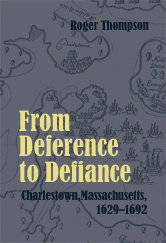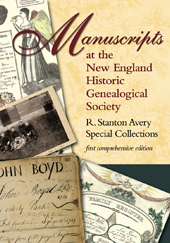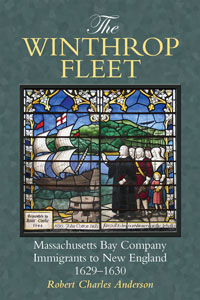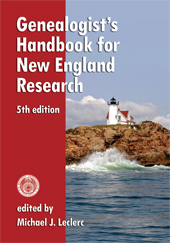 Why most people went to Charlestown during the seventeenth century we can only guess. Individuals were usually far too occupied during preparation, emigration, and plantation to record their reasons for undertaking this life-threatening ordeal. We can only adduce possible factors from the heart-searchings of such (hardly typical) emigrants as Governor Winthrop, and from the prevailing conditions in emigrant areas of England. Continue reading Why They Came
Why most people went to Charlestown during the seventeenth century we can only guess. Individuals were usually far too occupied during preparation, emigration, and plantation to record their reasons for undertaking this life-threatening ordeal. We can only adduce possible factors from the heart-searchings of such (hardly typical) emigrants as Governor Winthrop, and from the prevailing conditions in emigrant areas of England. Continue reading Why They Came
Tag Archives: The Well-Stocked Genealogical Library
Trust in a reputable firm
 I own some shares in mutual funds and have a basic understanding of the stock market, but I am in no way, shape, or form the person you want to talk to about investing your money. When I am trying to figure out how to invest my money, I face the same kind of information overload that a beginning genealogist faces. In both industries there are cautionary tales about not trusting everything that one reads. So who does one trust?
I own some shares in mutual funds and have a basic understanding of the stock market, but I am in no way, shape, or form the person you want to talk to about investing your money. When I am trying to figure out how to invest my money, I face the same kind of information overload that a beginning genealogist faces. In both industries there are cautionary tales about not trusting everything that one reads. So who does one trust?
One piece of universal advice is to trust “reputable firms.” In the case of investments, that might be called an oxymoron, but in genealogy we soon pick up on names of researchers and authors who have good reputations. As human beings, none are perfect, but because of their “best practices” some have gained our trust. Continue reading Trust in a reputable firm
Early Charlestown companies
 The “Great Migration” of as many as 20,000 people to New England during the 1630s was, in its long-term effects, the most important event in English seventeenth-century history. It has been depicted as a farther-reaching extension of an already mobile English population, though I have argued elsewhere that many emigrants to New England came from long-settled backgrounds. What distinguished the Great Migration was its family nature, as compared to the settling of the Chesapeake or the Caribbean, where individual young men predominated. Moreover, many arrivals in Salem, Charlestown, or Boston were members of “companies” – interrelated clans, or followers of gentlemen or ministers. Continue reading Early Charlestown companies
The “Great Migration” of as many as 20,000 people to New England during the 1630s was, in its long-term effects, the most important event in English seventeenth-century history. It has been depicted as a farther-reaching extension of an already mobile English population, though I have argued elsewhere that many emigrants to New England came from long-settled backgrounds. What distinguished the Great Migration was its family nature, as compared to the settling of the Chesapeake or the Caribbean, where individual young men predominated. Moreover, many arrivals in Salem, Charlestown, or Boston were members of “companies” – interrelated clans, or followers of gentlemen or ministers. Continue reading Early Charlestown companies
A considerable legacy in genealogy
 Samuel Gardner Drake was not a likely candidate to become the author of a multitude of historical works. Born on a farm in Pittsfield, New Hampshire, in 1798, he was not an eager pupil in his youth. “His aversion to school, when a little urchin,” as John H. Sheppard put it, “was particularly strong.” Drake recalled his initial dread of the school room: “My first impressions of that school were anything but pleasant. Being naturally very timid, I was sadly frightened at the stern look of the master. To learn my lessons seemed a desperate undertaking, and it was a long time before I could believe and feel I was not in danger of being annihilated.” Continue reading A considerable legacy in genealogy
Samuel Gardner Drake was not a likely candidate to become the author of a multitude of historical works. Born on a farm in Pittsfield, New Hampshire, in 1798, he was not an eager pupil in his youth. “His aversion to school, when a little urchin,” as John H. Sheppard put it, “was particularly strong.” Drake recalled his initial dread of the school room: “My first impressions of that school were anything but pleasant. Being naturally very timid, I was sadly frightened at the stern look of the master. To learn my lessons seemed a desperate undertaking, and it was a long time before I could believe and feel I was not in danger of being annihilated.” Continue reading A considerable legacy in genealogy
Special collections at NEHGS
 Among the holdings of the New England Historic Genealogical Society is an extensive collection of manuscripts dedicated to genealogical and local history material. Filling more than 5,000 feet of shelving and containing over 28 million individual items (some of which date back to the fourteenth century), this collection, known as the R. Stanton Avery Special Collections, offers members an incredible repository of information.
Among the holdings of the New England Historic Genealogical Society is an extensive collection of manuscripts dedicated to genealogical and local history material. Filling more than 5,000 feet of shelving and containing over 28 million individual items (some of which date back to the fourteenth century), this collection, known as the R. Stanton Avery Special Collections, offers members an incredible repository of information.
Individual entries are arranged by call number, which groups the items according to format: Continue reading Special collections at NEHGS
The Great Migration: Top-down, bottom-up
 The activities of the Massachusetts Bay Company in 1629-30 were uniformly organized from the top down. The Company either purchased or hired the vessels to carry the passengers and provisions. The passengers themselves, and especially the critically important professionals such as ministers and soldiers, were recruited by the Company leaders. Continue reading The Great Migration: Top-down, bottom-up
The activities of the Massachusetts Bay Company in 1629-30 were uniformly organized from the top down. The Company either purchased or hired the vessels to carry the passengers and provisions. The passengers themselves, and especially the critically important professionals such as ministers and soldiers, were recruited by the Company leaders. Continue reading The Great Migration: Top-down, bottom-up
Navigating Connecticut probate and court records
 More than the other New England states, Connecticut has kept its records in a variety of jurisdictions. Probate records can be particularly difficult to navigate. For Connecticut Colony, after 1639, estates were in the jurisdiction of the Particular Court (sometimes called the “Quarterly Court”). The Particular Courts were abolished with the new colony charter in 1662 and replaced by the Court of Assistants. Continue reading Navigating Connecticut probate and court records
More than the other New England states, Connecticut has kept its records in a variety of jurisdictions. Probate records can be particularly difficult to navigate. For Connecticut Colony, after 1639, estates were in the jurisdiction of the Particular Court (sometimes called the “Quarterly Court”). The Particular Courts were abolished with the new colony charter in 1662 and replaced by the Court of Assistants. Continue reading Navigating Connecticut probate and court records
Ships of the Winthrop Migration, 1629-1630
The Massachusetts Bay Company arranged for six vessels to sail for New England in 1629, only five of which reached their destination. The salient details for each of these sailings are summarized below:
George Bonaventure, Thomas Cox, master. She left the Isle of Wight 4 May 1629, and probably reached Salem during the first half of July. Samuel Sharp and the Rev. Samuel Skelton were two of the passengers. Continue reading Ships of the Winthrop Migration, 1629-1630
New England towns, counties, and states
 New England’s governmental organization is different from other areas of the United States, which can confuse genealogical researchers from outside the region. One major difference is in geopolitical subdivisions. Unlike other areas of the country, New England’s primary unit of government is the town. Continue reading New England towns, counties, and states
New England’s governmental organization is different from other areas of the United States, which can confuse genealogical researchers from outside the region. One major difference is in geopolitical subdivisions. Unlike other areas of the country, New England’s primary unit of government is the town. Continue reading New England towns, counties, and states
Assorted populations of the Great Migration
 While the majority of the immigrants to New England between 1620 and 1640 were Puritans of some variety, a minority were conventional, conforming members of the Church of England, or of no particular religious persuasion at all. For example, West Country fishermen created settlements in Monhegan, Casco, and Richmond Island during the 1620s and early 1630s, accounting for (roughly) one thousand immigrants, or about five percent of the whole Great Migration. Continue reading Assorted populations of the Great Migration
While the majority of the immigrants to New England between 1620 and 1640 were Puritans of some variety, a minority were conventional, conforming members of the Church of England, or of no particular religious persuasion at all. For example, West Country fishermen created settlements in Monhegan, Casco, and Richmond Island during the 1620s and early 1630s, accounting for (roughly) one thousand immigrants, or about five percent of the whole Great Migration. Continue reading Assorted populations of the Great Migration